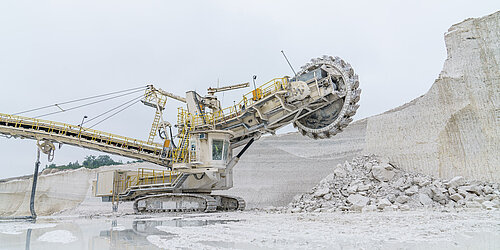How cement is produced conventionally
Production of one tonne of cement typically results in the release of 600 kilograms of CO2 into the environment. Most of this – around 65 percent – involves process-related emissions. The remaining 35 percent is produced by the combustion of fossil fuels to generate the high-temperature process heat. Even if only greenhouse gas-neutral fuels are used here, the process-related carbon emissions are still unavoidable. This problem of conventional cement production is illustrated in the following infographic.
Copyright: KEI
Production process
The raw material mined in the quarry (1) is crushed in the crusher and mill (2), and then placed into a silo (3) as raw meal for intermediate storage. The raw meal is then fed through the cyclone preheater (4), which preheats it with waste gas using the countercurrent flow principle to around 900 degrees and then routes it to the calciner (5). After exiting the calciner, the preheated raw meal enters the rotary kiln (6), where it is melted and bound to clinker at around 1,450 degrees. The temperature is reduced in the cooler (7) and the cement clinker is then crushed in a cement mill (8), with other components such as fly ash and slag sand being added. The end product is stored in a silo (9).
Process-related emissions unavoidable
This production process generates both fuel- and process-related greenhouse gas emissions. To date, fuel-related emissions have been released during the heating of the rotary kiln (6) with natural gas and coal. Process-related carbon emissions are generated in turn by the chemical process of the calcination of limestone at high temperatures in the calciner (5).
Contact
Bianca Dornisch-Bund
Project Funding
0355 47889-141
Write E-Mail
How cement production can become climate-neutral
To achieve climate neutrality in cement production, a whole series of measures for decarbonisation need to be implemented. Our infographic illustrates this process.
Go to infographic
